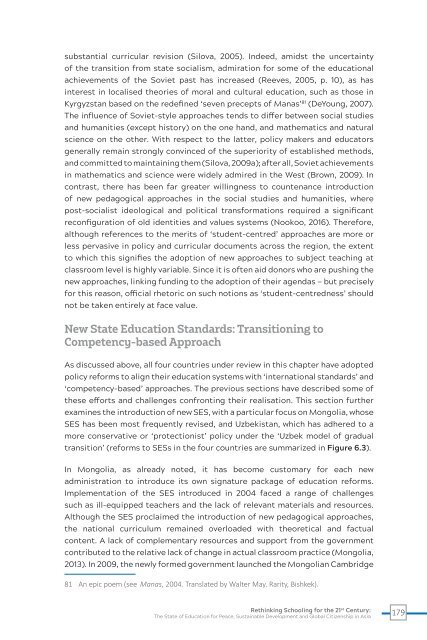Rethinking Schooling for the 21st Century
UNESCO MGIEP officially launched 'Rethinking Schooling for the 21st Century: The State of Education, Peace and Sustainable Development and Global Citizenship' in 2017 at the UNESCO General Conference. This study analyses how far the ideals of SDG 4.7 are embodied in policies and curricula across 22 Asian countries and establishes benchmarks against which future progress can be assessed. It also argues forcefully that we must redefine the purposes of schooling, addressing the fundamental challenges to efforts to promote peace, sustainability and global citizenship through education.
UNESCO MGIEP officially launched 'Rethinking Schooling for the 21st Century: The State of Education, Peace and Sustainable Development and Global Citizenship' in 2017 at the UNESCO General Conference. This study analyses how far the ideals of SDG 4.7 are embodied in policies and curricula across 22 Asian countries and establishes benchmarks against which future progress can be assessed. It also argues forcefully that we must redefine the purposes of schooling, addressing the fundamental challenges to efforts to promote peace, sustainability and global citizenship through education.
Create successful ePaper yourself
Turn your PDF publications into a flip-book with our unique Google optimized e-Paper software.
substantial curricular revision (Silova, 2005). Indeed, amidst <strong>the</strong> uncertainty<br />
of <strong>the</strong> transition from state socialism, admiration <strong>for</strong> some of <strong>the</strong> educational<br />
achievements of <strong>the</strong> Soviet past has increased (Reeves, 2005, p. 10), as has<br />
interest in localised <strong>the</strong>ories of moral and cultural education, such as those in<br />
Kyrgyzstan based on <strong>the</strong> redefined ‘seven precepts of Manas’ 81 (DeYoung, 2007).<br />
The influence of Soviet-style approaches tends to differ between social studies<br />
and humanities (except history) on <strong>the</strong> one hand, and ma<strong>the</strong>matics and natural<br />
science on <strong>the</strong> o<strong>the</strong>r. With respect to <strong>the</strong> latter, policy makers and educators<br />
generally remain strongly convinced of <strong>the</strong> superiority of established methods,<br />
and committed to maintaining <strong>the</strong>m (Silova, 2009a); after all, Soviet achievements<br />
in ma<strong>the</strong>matics and science were widely admired in <strong>the</strong> West (Brown, 2009). In<br />
contrast, <strong>the</strong>re has been far greater willingness to countenance introduction<br />
of new pedagogical approaches in <strong>the</strong> social studies and humanities, where<br />
post-socialist ideological and political trans<strong>for</strong>mations required a significant<br />
reconfiguration of old identities and values systems (Nookoo, 2016). There<strong>for</strong>e,<br />
although references to <strong>the</strong> merits of ‘student-centred’ approaches are more or<br />
less pervasive in policy and curricular documents across <strong>the</strong> region, <strong>the</strong> extent<br />
to which this signifies <strong>the</strong> adoption of new approaches to subject teaching at<br />
classroom level is highly variable. Since it is often aid donors who are pushing <strong>the</strong><br />
new approaches, linking funding to <strong>the</strong> adoption of <strong>the</strong>ir agendas — but precisely<br />
<strong>for</strong> this reason, official rhetoric on such notions as ‘student-centredness’ should<br />
not be taken entirely at face value.<br />
New State Education Standards: Transitioning to<br />
Competency-based Approach<br />
As discussed above, all four countries under review in this chapter have adopted<br />
policy re<strong>for</strong>ms to align <strong>the</strong>ir education systems with ‘international standards’ and<br />
‘competency-based’ approaches. The previous sections have described some of<br />
<strong>the</strong>se ef<strong>for</strong>ts and challenges confronting <strong>the</strong>ir realisation. This section fur<strong>the</strong>r<br />
examines <strong>the</strong> introduction of new SES, with a particular focus on Mongolia, whose<br />
SES has been most frequently revised, and Uzbekistan, which has adhered to a<br />
more conservative or ‘protectionist’ policy under <strong>the</strong> ‘Uzbek model of gradual<br />
transition’ (re<strong>for</strong>ms to SESs in <strong>the</strong> four countries are summarized in Figure 6.3).<br />
In Mongolia, as already noted, it has become customary <strong>for</strong> each new<br />
administration to introduce its own signature package of education re<strong>for</strong>ms.<br />
Implementation of <strong>the</strong> SES introduced in 2004 faced a range of challenges<br />
such as ill-equipped teachers and <strong>the</strong> lack of relevant materials and resources.<br />
Although <strong>the</strong> SES proclaimed <strong>the</strong> introduction of new pedagogical approaches,<br />
<strong>the</strong> national curriculum remained overloaded with <strong>the</strong>oretical and factual<br />
content. A lack of complementary resources and support from <strong>the</strong> government<br />
contributed to <strong>the</strong> relative lack of change in actual classroom practice (Mongolia,<br />
2013). In 2009, <strong>the</strong> newly <strong>for</strong>med government launched <strong>the</strong> Mongolian Cambridge<br />
81 An epic poem (see Manas, 2004. Translated by Walter May. Rarity, Bishkek).<br />
<strong>Rethinking</strong> <strong>Schooling</strong> <strong>for</strong> <strong>the</strong> 21 st <strong>Century</strong>:<br />
The State of Education <strong>for</strong> Peace, Sustainable Development and Global Citizenship in Asia<br />
179

















